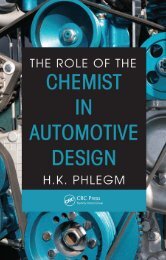Lightweight Electric/Hybrid Vehicle Design
Lightweight Electric/Hybrid Vehicle Design
Lightweight Electric/Hybrid Vehicle Design
Create successful ePaper yourself
Turn your PDF publications into a flip-book with our unique Google optimized e-Paper software.
38 <strong>Lightweight</strong> <strong>Electric</strong>/<strong>Hybrid</strong> <strong>Vehicle</strong> <strong>Design</strong><br />
2.3.3 NEW-CONCEPT ALUMINIUM BATTERY<br />
The cell invented by Rainer Partanen, Fig. 2.8, is an attempt to defeat the disadvantages of the<br />
aluminium–air cell. It is a secondary battery which uses coated aluminium for the anode and<br />
pure aluminium for the cathode. The electrolyte is a mixture of two elements: (a) an anion/<br />
cation solution currently consisting in proportion of 68 g of 25% ammonia water mixed with<br />
208 g of aluminium hydroxide, and made up with water to give 1 litre of solution; (b) a semiorganic<br />
additive consisting of metal amines.<br />
The exact formulation of the additive is a commercial secret. The inventor claims that this<br />
electrolyte achieves a large increase in charge carrier mobility and this results in figures of up to<br />
1246 Wh/kg and 2100 Wh/litre, which have been achieved in many prototype cells that have<br />
been constructed. The figures relate to active materials, without casing. It is suggested that the<br />
technology is suitable for the construction of plate (wet cell) and foil (sealed) cells, with no<br />
limitations on capacity. The test cells have achieved a life of up to 3000 cycles, the main<br />
degradation mechanism being corrosion of the coating on the anode during recharging. One<br />
remaining hurdle to be overcome is the identification of a better coating material to reduce the<br />
corrosion.<br />
The battery has some unusual characteristics in that it operates over a very wide temperature<br />
range, −40 to +70° C. This is in stark contrast to most batteries whose low temperature/high<br />
temperature performance is poor. The cell voltage is a nominal 1.5 V. Some interesting<br />
consequences arise if one assumes that the claims are true. The most significant is packaging. If<br />
we take the D cell which is 32 mm diameter × 58 mm long, as used by Panasonic/Toyota in the<br />
PRIUS battery pack, a battery with 150 g active mass stores 6.8 Ah and has a peak discharge<br />
current of around 100 amps. If we build a D Cell at a value of 1246 Wh/kg, this leads to a figure<br />
of 150 Ah. Polaron understand that very high levels of discharge current are possible – the<br />
inventor claims up to 20 times more power than existing cells in the market – but finding<br />
methods of supporting these currents in such a small space is a major challenge to achieve low<br />
terminal resistance, lead-outs and sealing, Fig. 2.9. It is claimed that the new technology uses<br />
environmentally safe materials which are fully recyclable.<br />
Other developments which lend support to this invention9 are the emergence of<br />
ultracapacitors and electrolytic capacitors, both using aluminium electrodes with biological<br />
Leclanch Alkaline Lead–acid Ni–Cad Ni–Mh Lithium–ion Aluminium<br />
Amp. hrs (20) 4.5 18 2.5 4.0 6.5 18 150 (75 Dem)<br />
Cell voltage 1.5 1.5 2.0 1.2 1.2 3.6 1.5<br />
Max C rate 2C 2C 40C 25C 11C 40C 3C<br />
AH/25° C Not possible 0.5 3.0 5.0 14 Not possible at<br />
present IR limited 2 Package IR limits<br />
current to 500 A<br />
Aluminium metal in anode/cathode 486 g 180 cm 3<br />
Anion/cation reactant solution 1199 g 820 cm 3<br />
Theoretical maximum energy and current capacity<br />
2100 Wh/litre 1448 Ah/litre<br />
1246 Wh/kg 859 Ah/kg<br />
Practical cells in a package should achieve 70–80% of the above values when package mass is included.<br />
Fig. 2.8 Characteristics of D cell (32 × 62 mm) against those of a 1 litre Partanen cell.







